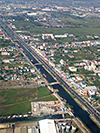|
Khlong Rangsit Prayoonsak (คลองรังสิตประยูรศักดิ์)
Thai. Name of a
major canal in northern
Bangkok,
that
connects
the
Chao Phraya
River (fig.) in
Pathum Thani
with
Nakhon Nayok
in the East.
It was the first
irrigation canal of
Siam
to be dug North of
Rattanakosin
and its
construction, which took 14 years, was carried out by Prince
Saai Sanithawong (fig.),
after receiving the concessions for the dig
in
1890 AD. Prior to this, he had been the first deputy chief of naval operations,
with
the rank of Navy Vice-Admiral.
The project became his personal endeavor and legacy, which he
carried out under the name Siam Canal and Irrigation Company, and with the aid of his son
Momratchawong
Suwaphan Sanithawong
(fig.),
who –as a physician educated in Scotland– assisted his father both
in the field of medicine and in this company.
By royal decree, the canal was
named
after
Rangsit Prayoonsak (fig.),
the the 52nd child of King
Rama V
(fig.), who
was also known as
the Prince of
Chainat.
The canal is
in
short often referred to as the Rangsit Canal,
while the local populace usually
refer to it as Khlong
Chao
Saai (คลองเจ้าสาย), i.e.
the ‘Prince
Saai Canal’,
in honour of its builder, whose
statue, together with that of
his assistant and
son
(fig.)
today stands in a
Buddhist temple located along the canal, in close proximity to the Northern
Bangkok University.
In addition, the canal is by some nicknamed
Khlong
8
Wah
(คลอง 8 วา), after its initial width.
See MAP.
回






|

